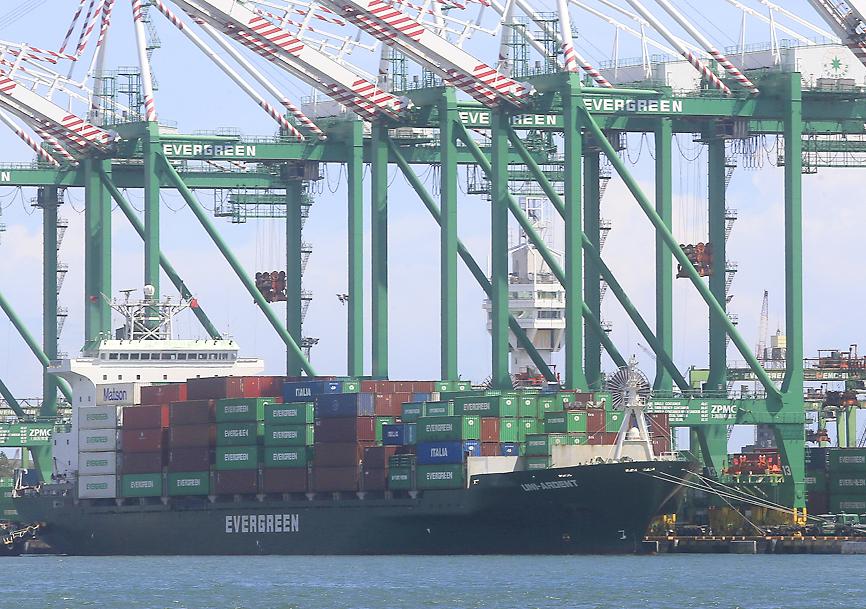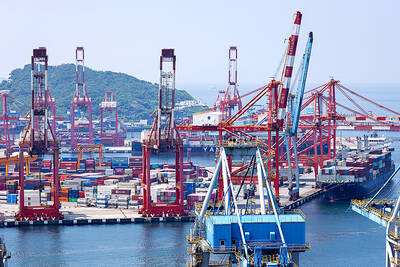Taiwan’s exports soared 11.2 percent year-on-year to a record US$32.23 billion last month, as tech firms continued to thrive on the low-contact economy, while most traditional sectors stopped being a drag, the Ministry of Finance said yesterday.
“The showing is surprisingly strong and might sustain this month and beyond, with demand for 5G devices, advanced chips and remote technology applications poised to gain steam ahead of the high season,” said Department of Statistics Director-General Beatrice Tsai (蔡美娜), who had earlier projected a mild decline for last month due to fewer working days and the disappearance of inventory stockpiling by China’s Huawei Technology Co (華為).
Bloomberg reported that excluding February’s data because of the extended Lunar New Year holiday, last month’s exports rose by the fastest pace since May 2018.

Photo: CNA
Exports are expected to rise by 5 to 8 percent this month, Tsai said, adding that the landscape moving forward looks bright for technology products.
The releases of Apple Inc’s new iPhones and other smartphone brands have been boosting business for local firms that supply their components, she said.
That helped explain why outbound shipments of electronics jumped 21.8 percent to US$12.97 billion, while information and communication products grew 22.2 percent to US$4.64 billion, Tsai said.
Those two categories are set to break records this year and would help avoid an annual decline in overall exports, she said.
Optical devices grew 14.2 percent from a year earlier, buoyed by strong demand for TV panels, which offset a 13.6 percent fall in shipments of smartphone camera lenses, the ministry’s report showed.
Exports of chemical, plastic and base metal products saw increases of 0.4 percent to 8.8 percent, reversing nearly two years of slumps after customers started to rebuild inventory, Tsai said.
The fledgling recovery did not apply to makers of mineral and textile products, which tumbled 61.3 percent and 6.9 percent respectively from their year-ago levels, as the COVID-19 pandemic slashed international travel and hurt their business, Tsai said.
Demand from all major trading partners worldwide picked up last month, lending support to a broad-based recovery, but Tsai said it is safer to watch for a while longer.
Exports to China and Hong Kong rose 16.9 percent, while shipments to the US increased 21.4 percent.
Imports fell 1 percent to US$24.77 billion, giving Taiwan a record trade surplus of US$7.46 billion, an 88.9 percent spike from a year earlier, the ministry said.
Imports of capital equipment rose 8.6 percent, mostly among local semiconductor firms seeking to maintain their global technology edge, the ministry added.
Widening trade surpluses are aggravating Taiwan’s trade imbalance with the US and driving up the New Taiwan dollar against the US greenback, but the NT dollar’s strength appears to have done little to temper overseas demand for Taiwanese products.
For the first 10 months of the year, exports totaled US$280.31 billion, a 3.4 percent increase over last year, dimming the chance of an annual drop for the major growth driver as forecast earlier by the government, Tsai said.
Imports maintained their retreat, slipping 0.8 percent to US$232.53 billion, weighed down by cheaper oil and raw material prices.
Additional reporting by Bloomberg

Nvidia Corp chief executive officer Jensen Huang (黃仁勳) on Monday introduced the company’s latest supercomputer platform, featuring six new chips made by Taiwan Semiconductor Manufacturing Co (TSMC, 台積電), saying that it is now “in full production.” “If Vera Rubin is going to be in time for this year, it must be in production by now, and so, today I can tell you that Vera Rubin is in full production,” Huang said during his keynote speech at CES in Las Vegas. The rollout of six concurrent chips for Vera Rubin — the company’s next-generation artificial intelligence (AI) computing platform — marks a strategic

REVENUE PERFORMANCE: Cloud and network products, and electronic components saw strong increases, while smart consumer electronics and computing products fell Hon Hai Precision Industry Co (鴻海精密) yesterday posted 26.51 percent quarterly growth in revenue for last quarter to NT$2.6 trillion (US$82.44 billion), the strongest on record for the period and above expectations, but the company forecast a slight revenue dip this quarter due to seasonal factors. On an annual basis, revenue last quarter grew 22.07 percent, the company said. Analysts on average estimated about NT$2.4 trillion increase. Hon Hai, which assembles servers for Nvidia Corp and iPhones for Apple Inc, is expanding its capacity in the US, adding artificial intelligence (AI) server production in Wisconsin and Texas, where it operates established campuses. This

Garment maker Makalot Industrial Co (聚陽) yesterday reported lower-than-expected fourth-quarter revenue of NT$7.93 billion (US$251.44 million), down 9.48 percent from NT$8.76 billion a year earlier. On a quarterly basis, revenue fell 10.83 percent from NT$8.89 billion, company data showed. The figure was also lower than market expectations of NT$8.05 billion, according to data compiled by Yuanta Securities Investment and Consulting Co (元大投顧), which had projected NT$8.22 billion. Makalot’s revenue this quarter would likely increase by a mid-teens percentage as the industry is entering its high season, Yuanta said. Overall, Makalot’s revenue last year totaled NT$34.43 billion, down 3.08 percent from its record NT$35.52

PRECEDENTED TIMES: In news that surely does not shock, AI and tech exports drove a banner for exports last year as Taiwan’s economic growth experienced a flood tide Taiwan’s exports delivered a blockbuster finish to last year with last month’s shipments rising at the second-highest pace on record as demand for artificial intelligence (AI) hardware and advanced computing remained strong, the Ministry of Finance said yesterday. Exports surged 43.4 percent from a year earlier to US$62.48 billion last month, extending growth to 26 consecutive months. Imports climbed 14.9 percent to US$43.04 billion, the second-highest monthly level historically, resulting in a trade surplus of US$19.43 billion — more than double that of the year before. Department of Statistics Director-General Beatrice Tsai (蔡美娜) described the performance as “surprisingly outstanding,” forecasting export growth